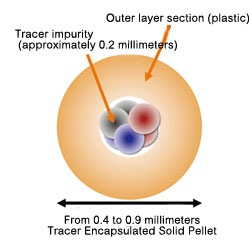HOME > Research Activities > Research Updates >
In order to realize the future fusion energy generation it is necessary to maintain high-temperature plasma confined by a magnetic field. However, because impurities injected into a high-temperature plasma cause the plasma’s energy to be emitted as light, when the amount of impurities increases the temperature of the plasma falls. Thus, appropriately controlling the amount of impurities mixing into a plasma is an important issue, and the behavior of impurities in a high-temperature plasma is being investigated through various methods. Among these methods is investigating the behavior of impurities in a high-temperature plasma through the injection of impurities from outside the plasma. Here we will introduce research on impurities that uses a unique method of pinpoint injection of impurities called “Tracer Encapsulated Pellets” that was developed in the Large Helical Device (LHD).
High-temperature plasma that is confined in the magnetic field lines container does not directly touch the wall of the vessel. However, little by little “impurities” such as iron, which is a material from which the wall was composed, and carbon, which was affixed to the wall, mixes into a plasma. We are energetically investigating the behavior of impurities in high-temperature plasma because impurities which have entered into a plasma emit as light one part of the energy absorbed from the plasma and result in the cooling of the plasma. However, in some instances it is difficult to understand subtle changes in the behavior of iron and other impurities which commonly appear in a plasma because a certain amount of impurities are already present. In contrast, when we venture to inject an impurity that would never otherwise enter a plasma, we can investigate its behavior, even the subtle changes, with high accuracy. The impurity purposely injected from outside into a plasma is called a “tracer impurity.” This term means an impurity that is possible to trace.
A solid tracer impurity is a small solid object (called a pellet) that is approximately one millimeter in size. Using a thin tube the impurity is injected at a high speed into the plasma following the principle of a blowpipe. As it enters the plasma, the impurity melts and is absorbed into the plasma. At this time, because one part of the tracer impurity is absorbed by the plasma outside the magnetic field lines container, we encounter the problem of not knowing precisely how much of the tracer impurity reached the high-temperature plasma inside the magnetic field lines container. In order to overcome this, a “tracer encapsulated solid pellet” was developed in the LHD.
The tracer encapsulated pellet has a tracer impurity inside a hollow plastic ball, and is of a two–level composition. From this composition while it is passing through the plasma outside the magnetic field lines container, the external portion of the plastic part only, because it has been manufactured to do so, will melt. Thus we can inject the impurity in a pinpoint manner into the high-temperature plasma inside the container. Further, because the amount of tracer impurity that will be encapsulated into the plastic ball has been precisely determined, we can investigate with high accuracy the behavior inside the plasma into which it has been injected. Moreover, by adjusting the thickness of the plastic’s outer shell and changing the depth of the entry before it melts, we can directly inject the tracer impurity to a place we wish to investigate.
Taking advantage of this special characteristic of the tracer encapsulated solid pellet, we investigated the behavior of an impurity in a place in the magnetic field lines container, which is in a nested state like tree rings, which resembled a knot. The presence of this knot in the magnetic field lines container typically imparts a poor influence upon plasma confinement. Using computer tomography technology, having analyzed the behavior through these images we clarified that the tracer impurity had stayed in this place resembling a knot for a comparatively long period of time.
In the future, too, we will move ahead with research that fully utilizes the advantages of the tracer encapsulated solid pellet developed by the LHD. We will clarify the behavior of impurities mixed in a plasma and we will aim to establish methods for controlling that behavior.
 |
|---|
| The tracer encapsulated solid pellet is composed of two layers with multiple internal parts for tracer impurities set in hollow plastic balls (microspheres that are less than 0.2 millimeters in diameter). The full diameter, depending upon the experiment, may be selected from between 0.4 millimeters and 0.9 millimeters. |
